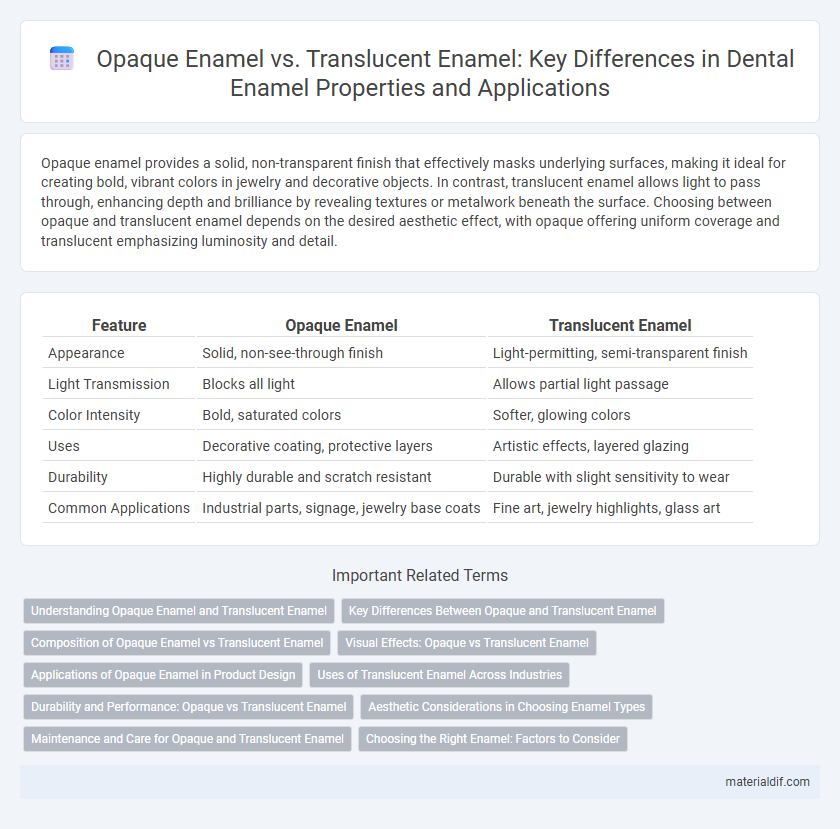Opaque enamel provides a solid, non-transparent finish that effectively masks underlying surfaces, making it ideal for creating bold, vibrant colors in jewelry and decorative objects. In contrast, translucent enamel allows light to pass through, enhancing depth and brilliance by revealing textures or metalwork beneath the surface. Choosing between opaque and translucent enamel depends on the desired aesthetic effect, with opaque offering uniform coverage and translucent emphasizing luminosity and detail.
Table of Comparison
| Feature | Opaque Enamel | Translucent Enamel |
|---|---|---|
| Appearance | Solid, non-see-through finish | Light-permitting, semi-transparent finish |
| Light Transmission | Blocks all light | Allows partial light passage |
| Color Intensity | Bold, saturated colors | Softer, glowing colors |
| Uses | Decorative coating, protective layers | Artistic effects, layered glazing |
| Durability | Highly durable and scratch resistant | Durable with slight sensitivity to wear |
| Common Applications | Industrial parts, signage, jewelry base coats | Fine art, jewelry highlights, glass art |
Understanding Opaque Enamel and Translucent Enamel
Opaque enamel is designed to completely block underlying colors or materials, providing a solid, uniform surface ideal for covering flaws or creating distinct, vibrant patterns. Translucent enamel allows light to pass through partially, enhancing depth and dimension while showcasing the texture or color beneath for a more luminous effect. The choice between opaque and translucent enamel depends on the desired aesthetic, durability, and how much the underlying substrate color should influence the final appearance.
Key Differences Between Opaque and Translucent Enamel
Opaque enamel is characterized by its ability to completely block light, providing a solid, non-transparent finish ideal for covering imperfections or creating bold, vibrant colors. Translucent enamel allows light to pass through, enhancing depth and luminosity for a more natural and glowing appearance often used in fine jewelry and decorative arts. The key differences lie in their light transmission properties and visual effects, influencing the enamel's application based on aesthetic requirements.
Composition of Opaque Enamel vs Translucent Enamel
Opaque enamel contains a higher concentration of opacifying agents such as tin oxide or zirconium silicate, which block light transmission to mask underlying structures. Translucent enamel is formulated with fewer or no opacifiers and has a higher glass content, allowing light to pass through for a more natural, lifelike appearance. The difference in composition fundamentally affects the optical properties and clinical applications of each enamel type in dental restorations.
Visual Effects: Opaque vs Translucent Enamel
Opaque enamel offers solid, vibrant colors that effectively mask underlying surfaces, providing a uniform and bold visual effect ideal for intricate designs. Translucent enamel allows light to pass through, creating depth and a luminous, glass-like appearance that enhances details with subtle shading and color variations. Choosing between opaque and translucent enamel impacts the brightness, texture, and overall aesthetic quality of enamel art or jewelry.
Applications of Opaque Enamel in Product Design
Opaque enamel offers superior coverage and vibrant color retention, making it ideal for product design elements requiring bold, uniform surfaces. Its ability to mask underlying materials enhances the aesthetic appeal of metalware, kitchen appliances, and signage. This enamel type also provides excellent protection against corrosion, ensuring durability in both decorative and functional applications.
Uses of Translucent Enamel Across Industries
Translucent enamel is extensively utilized in the jewelry industry for its ability to enhance the depth and brilliance of colors while maintaining a smooth, glossy surface. In the automotive sector, translucent enamel coatings provide durable, vibrant finishes that resist environmental wear and UV radiation. Electronics manufacturers apply translucent enamel for protective coatings on components, ensuring both aesthetic appeal and insulation properties.
Durability and Performance: Opaque vs Translucent Enamel
Opaque enamel provides superior durability due to its dense composition, making it highly resistant to wear, chipping, and discoloration over time. Translucent enamel offers enhanced aesthetic performance with light diffusion qualities but tends to be more susceptible to surface scratches and fading under heavy use. Selecting between opaque and translucent enamel depends on balancing the need for long-lasting protection with visual appeal in specific applications.
Aesthetic Considerations in Choosing Enamel Types
Opaque enamel provides superior coverage and effectively masks underlying tooth discolorations, making it ideal for achieving uniform color in restorations. Translucent enamel, with its light-transmitting properties, enhances the natural depth and vitality of dental work, closely mimicking the appearance of real teeth. Selecting between opaque and translucent enamel depends on balancing the need for concealment against the desire for lifelike aesthetics in restorative dentistry.
Maintenance and Care for Opaque and Translucent Enamel
Opaque enamel requires careful cleaning with non-abrasive materials to prevent surface dulling, while translucent enamel demands gentle handling to maintain its clarity and depth. Both types benefit from avoiding harsh chemicals and extreme temperature changes that can cause cracking or discoloration. Regular professional inspections help detect early signs of wear or damage, ensuring long-lasting enamel quality.
Choosing the Right Enamel: Factors to Consider
Opaque enamel provides strong color masking and is ideal for covering underlying materials or imperfections, while translucent enamel allows light to pass through, highlighting depth and enhancing the natural appearance of surfaces. Factors to consider when choosing between opaque and translucent enamel include the desired aesthetic effect, substrate color, and the level of durability required for the application. The choice directly influences the final visual outcome and performance, making it essential to match enamel properties with project specifications.
Opaque Enamel vs Translucent Enamel Infographic

 materialdif.com
materialdif.com